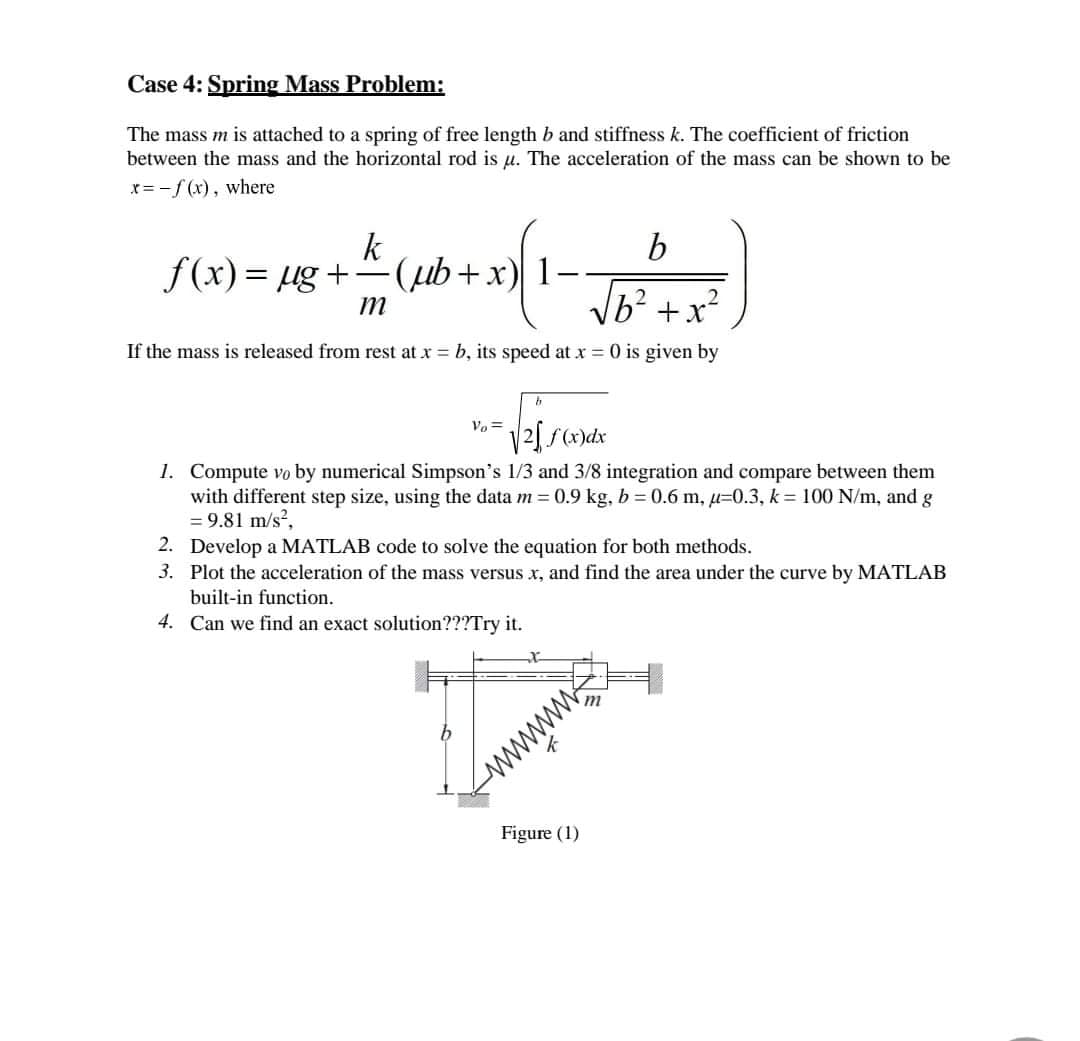Case 4: Spring Mass Problem: The mass m is attached to a spring of free length b and stiffness k. The coefficient of friction between the mass and the horizontal rod is u. The acceleration of the mass can be shown to be x= -f(x), where b √√√b² + x²² 2 2 If the mass is released from rest at x = b, its speed at x = 0 is given by k ƒ(x) = µg + ¹² (µb+x) 1- - m Vo = √2[ f(x)dx 1. Compute vo by numerical Simpson's 1/3 and 3/8 integration and compare between them with different step size, using the data m = 0.9 kg, b = 0.6 m, µ=0.3, k = 100 N/m, and g = 9.81 m/s²,
Case 4: Spring Mass Problem: The mass m is attached to a spring of free length b and stiffness k. The coefficient of friction between the mass and the horizontal rod is u. The acceleration of the mass can be shown to be x= -f(x), where b √√√b² + x²² 2 2 If the mass is released from rest at x = b, its speed at x = 0 is given by k ƒ(x) = µg + ¹² (µb+x) 1- - m Vo = √2[ f(x)dx 1. Compute vo by numerical Simpson's 1/3 and 3/8 integration and compare between them with different step size, using the data m = 0.9 kg, b = 0.6 m, µ=0.3, k = 100 N/m, and g = 9.81 m/s²,
Advanced Engineering Mathematics
10th Edition
ISBN:9780470458365
Author:Erwin Kreyszig
Publisher:Erwin Kreyszig
Chapter2: Second-order Linear Odes
Section: Chapter Questions
Problem 1RQ
Related questions
Question
Hello i need answer of this case using numerical methods
((Simpson's 1/3 and simpson's 3/8 ))
Pls include all steps
And thank u

Transcribed Image Text:Case 4: Spring Mass Problem:
The mass m is attached to a spring of free length b and stiffness k. The coefficient of friction
between the mass and the horizontal rod is u. The acceleration of the mass can be shown to be
x= -f (x), where
k
f(x)= µg +-(ub+x)
b
1-
If the mass is released from rest at x = b, its speed at x = 0 is given by
Vo =
2 f(x)dx
1. Compute vo by numerical Simpson's 1/3 and 3/8 integration and compare between them
with different step size, using the data m = 0.9 kg, b = 0.6 m, µ=0.3, k = 100 N/m, and g
= 9.81 m/s?,
2. Develop a MATLAB code to solve the equation for both methods.
3. Plot the acceleration of the mass versus x, and find the area under the curve by MATLAB
built-in function.
4. Can we find an exact solution???Try it.
www
Figure (1)
Expert Solution
This question has been solved!
Explore an expertly crafted, step-by-step solution for a thorough understanding of key concepts.
Step by step
Solved in 2 steps

Recommended textbooks for you

Advanced Engineering Mathematics
Advanced Math
ISBN:
9780470458365
Author:
Erwin Kreyszig
Publisher:
Wiley, John & Sons, Incorporated

Numerical Methods for Engineers
Advanced Math
ISBN:
9780073397924
Author:
Steven C. Chapra Dr., Raymond P. Canale
Publisher:
McGraw-Hill Education

Introductory Mathematics for Engineering Applicat…
Advanced Math
ISBN:
9781118141809
Author:
Nathan Klingbeil
Publisher:
WILEY

Advanced Engineering Mathematics
Advanced Math
ISBN:
9780470458365
Author:
Erwin Kreyszig
Publisher:
Wiley, John & Sons, Incorporated

Numerical Methods for Engineers
Advanced Math
ISBN:
9780073397924
Author:
Steven C. Chapra Dr., Raymond P. Canale
Publisher:
McGraw-Hill Education

Introductory Mathematics for Engineering Applicat…
Advanced Math
ISBN:
9781118141809
Author:
Nathan Klingbeil
Publisher:
WILEY

Mathematics For Machine Technology
Advanced Math
ISBN:
9781337798310
Author:
Peterson, John.
Publisher:
Cengage Learning,

